Arts & Sciences Research Paper #28: Socks From Post Roman (Coptic) Egypt
Our 28th A&S Research Paper comes to us from THL Ibrahim al-Rashid. Ibrahim currently lives in the Canton of Whyt Wey in the Crown Province of Ostgardr. In this paper he takes us deep into his research on naalbinding, providing evidence of nalbound socks from post-Roman Egypt, and ending his paper by discussing the availablity of evidence for nalbound socks elsewhere in the Roman empire.
Socks From Post Roman (Coptic) Egypt
Lord Ibrahim al-Rashid
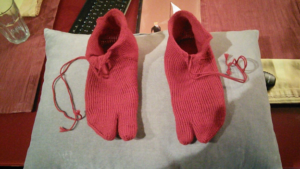
Due to the climate in Egypt, the conditions there are very favorable for the preservation of textiles in archaeological contexts. There is therefore a huge number of textiles and textile fragments from various eras of Egyptian history extant in museums around the world. Many museums hold socks from Egypt dating to the post-Roman (sometimes called Coptic) period, roughly the 3rd to the 7th centuries of the Common Era.
Egypt became a part of the Roman empire in approximately 30 BCE. However, aside from some high-ranking imperial officials, the majority of the “Romanized” population in Egypt remained Greek-speaking and could more properly be described as “Hellenized”. When we speak of “post-Roman” Egypt, we are really speaking of the period following the division of the Roman empire into its Eastern and Western halves. Egypt remained under the rule of the Eastern Roman (Byzantine) empire until it was conquered by the expanding Arab Muslim empire in the 7th century CE.
Culture within Egypt during this time, including fashions in dress, was a mixture of Hellenic, Roman, and native Egyptian practices. The period is characterized by the dominance of Christianity and the development of the Coptic church (a uniquely Egyptian sect which survives to this day). Most of the surviving socks come from Greek-speaking Christian sites within Egypt and should be understood in that context. While most of the surviving socks have been dated to the post-Roman era (3rd-7th centuries), more recent radio-carbon dating has confirmed that some may be from as early as the 1st century, CE. (Van Strydonck) . Even these earlier centuries in Egypt still represent a mixture of Hellenized Roman and native Egyptian culture, but without the dominant influence of Christianity.
Surviving socks
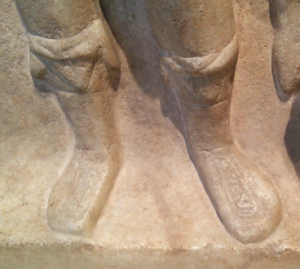
In order to understand the socks from Egypt, it is necessary to discuss briefly the types of shoes worn in this period. Archaeological finds include caligae (boots) and carbatinae (shoes). Either of these could be closed or formed from an open mesh of leather. In addition to these characteristically Roman styles, a more typically Byzantine style is also found in Egypt during this period, usually described as a slipper. These are slip-on shoes of a very basic form, whereas caligae and carbatinae seem to have typically been laced closed. Lastly, there were soleae (sandals). While soleae could get very elaborate, in their most basic form, they look like modern flip-flop style sandals. The Metropolitan Museum of Art indicates that “Written evidence suggests that sandals [soleae] were worn by government officials, slippers by monks and clergy, and boots [caligae] by soldiers and laborers; the poorest members of society would have gone barefoot.” (Metropolitan Museum of Art, display placard). Many varieties of socks can be worn with the carbatinae, caligae, and slippers. However, due to the presence of a leather thong between the first and second toes, soleae, if worn with socks, require a specially made sock with separate compartments for the first toe and the minor toes.
There are two main types of surviving socks from the Roman empire, including from Roman Egypt, and from post-Roman Egypt: socks made from woven cloth and socks made with the nalbinding technique. (Kostner) My focus here is on the socks made with nalbinding. These can be further divided into those employing the Coptic stitch (also referred to as “Coptic knitting”, crossed looping, and Tarim stitch) and those employing compound nalbinding structures.
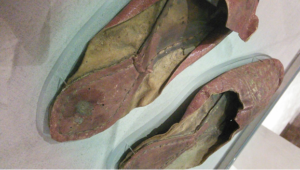
Nalbinding
Nalbinding (also called needle-looping or knotless netting) is made using finite lengths of yarn on a needle with an eye using a technique similar to sewing or embroidery. The yarn is formed into a series of loops which form a flexible and stretchy fabric. The structure of the Coptic stitch is very basic. Each stitch is a simple loop that crosses behind (or in front of) itself. In forming each stitch, the needle passes behind a stitch in the previous row, specifically passing behind the part of the stitch where the yarn crosses itself. (Figure 1) This stitch is employed in the majority of surviving socks from Egypt. There is one child’s sock at the Victoria & Albert Museum which appears to employ a variant in which the connection to the previous row passes through the loop, rather than behind the crossing of the previous row’s stitch. (analysis mine) The Coptic stitch is found in nalbound items from outside of Egypt, as well. The phrase “compound stitch” in this context refers to any stitch structure other than the Coptic stitch. Specifically, in compound nalbinding stitches, each stitch connects through one or more stitches in the same row. In the Coptic stitch, as can be seen in Figure 1, each stitch only connects with stitches in the row above and the row below. There are many possible variants of the complex nalbinding stitches, and these are common in European contexts, especially Scandinavia. At least 9 different stitch structures have been documented in socks from post-Roman Egypt. (Bottcher) I will use Hansen’s notation for nalbinding structures to refer to specific stitches. (Hansen) In either case, the nature of nalbinding and the way the stitches and rows form makes it especially suited to creating tubular and bag-like structures. So, it is especially suited for making socks. The elastic nature of the resulting fabric helps create a close fit as well, which is very advantageous in a sock.
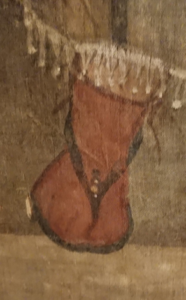
Socks in Coptic stitch
Nearly all of the surviving socks in the Coptic stitch have a division between the first toe and the lesser toes. This indicates use with soleae or a similar type of sandal. The scarcity of socks in the Coptic stitch with an undivided toe is quite striking. Even socks made to fit infants or toddlers exhibit the characteristic divided toe.
The overall structure of socks in the Coptic stitch is remarkably consistent. In addition to having a divided toe, the heel is shaped in essentially the same manner in all the surviving socks of this type. This structure was described by Dorothy Burnham in a study of the socks from two museum collections. (Burnham) Analysis of socks from other collections has so far not revealed any exceptions to the construction method she describes. (Kostner, 2017 and Decker) The two toe sections are worked separately, beginning with a small ring of stitches and working up from the tips. The lateral section is shaped by a series of increase stitches on the lateral edge. The two sections are then joined and the foot section is worked up to the instep. A heel flap is worked back and forth to create the heel part of the sole and the work is interrupted at the back of the heel. A square heel is formed by working back and forth to create the sides and back of the heel part. When the sides of the heel have reached the proper height, work resumes in the round, usually creating a welt across the top of the instep (continuous with a welt formed on either side of the heel). This welt, while serving as the functional connection between the foot section and the heel/ankle section, is also decorative and resembles a twisted cord. All of the socks worked in the Coptic stitch appear to be ankle-length.
The primary type of variation seen among these socks is in the way the top is finished. There are some socks which are simply worked up to the top edge in the same manner, forming a plain top. This pair in the Victoria & Albert Museum have a slit at the front of the ankle and remnants of cord (presumably used to tie around the ankle) at the top corners. This seems to be a common configuration. It is formed by working back-and-forth after doing several rows of the ankle section in the round.
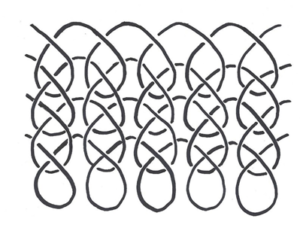
This sock at the Royal Ontario Museum has a front slit with the two sides overlapping. However, plain-top socks with no slit also exist, as do socks with two slits that form a tongue between them. Some socks have ribbing, created by working some columns of stitches into the previous rows from the back to the front, rather than front to back (analagous to purling in knitted material). A very small number show more complex patterns created by combining ‘knit’ and ‘purl’ type stitches. There are even some surviving examples with a fringe around the top opening. (Santrot)
The adult size socks in Coptic stitch are almost universally monochrome, as can be seen from the above examples. The children’s socks are often formed of multicolored stripes. Some examples can be found in the British Museum, in the Manchester Museum, and in the Royal Ontario Museum. The surviving socks are dyed in bright and dark colors, and examples of every color in the spectrum can be found. However, there are hardly any examples in white or off-white colors. One of these socks has been subjected to multispectral dye analysis and included fibers dyed with madder, indigo, weld, and tannins as well as alum mordant. (Dyer) The socks in Coptic stitch that I have found are all made of wool. There are examples of S- and Z-spun yarns, and 2-ply, 3-ply, and 4-ply yarns have been described.
Socks in compound stitches
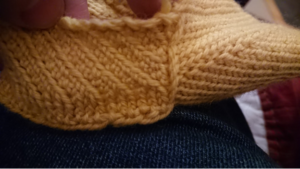
The socks worked in compound stitches are less common than those worked in Coptic stitch. There are many stitch types employed in the surviving examples. The Museum der Kulturen in Basel, Switzerland has an especially large collection of Egyptian socks in compound nalbinding stitches. There are 9 different stitch types represented in this collection. (Bottcher) There are 3 items using single-phase stitches (UU/OOO and UUU/OOOO) and over 20 items using 2-phase stitches (with the most common by far being UOO/UUOO, with two different types of connecting stitches). In addition, Bottcher includes one item with a very unusual stitch type, not easily described in Hansen’s notation. [Unfortunately, the Museum der Kulturen does not have publicly available photos of their amazing collection] I have not found any published analysis of the stitch types in socks from Egypt in other collections. However, my conclusion, based on photographs of the socks (such as this embroidered example in the British Museum and this especially large pair in the Museo Egidio in Florence) is that these are probably of the UOO/UUOO or UO/UOO stitch type (both of which are attested in Bottcher’s sample).
Socks in compound stitch types are more likely to have an undivided toe than those in Coptic stitch. Those with split toes and those with undivided toes are both common among the examples I have found (with undivided toes being slightly more common in this group). There are several reasons why this may be. Firstly, the compound stitches create a slightly thicker fabric (assuming the same thickness of the yarn) than the Coptic stitch does. Having additional thickness in between the toes would be less comfortable when wearing soleae type sandals. Second, because the compound stitches can produce a thicker fabric, they may have been used when a warmer foot covering was desired. This desire for warmth may or may not correlate with the use of closed shoes – especially in light of the cultural connotations associated with different types of shoes (as mentioned in the Metropolitan Museum’s description quoted above). There does not seem to be any correlation between the size of the socks (adult vs. child) and the use of split vs. undivided toes.
The heel construction of compound stitch socks is slightly different from that used for the Coptic stitch socks, but is also remarkably consistent throughout the samples. Whether or not the toe is split, the foot portion of the sock consists of a tube worked up to the instep. The heels of these socks are composed of a series of short rows forming a triangular or trapezoidal shape extending back from the sole of the foot portion. The steepness of the triangle sides varies somewhat, but the general shape is nearly universal. There are occasionally additional back-and-forth rows to enlarge the triangular heel flap. The stitching then resumes from the front/instep along the ends of the short rows and continues up into the ankle/leg portion.
The compound stitch socks vary in length as well. This is consistent with the variation in the types of closed-toe shoes worn in the Roman empire and Byzantine empire. Some of the socks are ankle length, like the Coptic stitch ones. But other socks appear to be mid-calf or calf length. With one exception, none of the complex stitch socks have structural variation at the cuff. However, some have decorative color patterns at the cuff.
These socks also display a wide range of colors. Most of them are made of wool. I have found very little information on the details of the yarn in these socks (thickness, spin direction, plies, etc.). However, some of the compound stitch socks are made of linen or cotton. The vegetable fiber socks are all primarily white or off-white; one has a small number of stripes in a blue color (probably from indigo) that are only one or two rows wide.
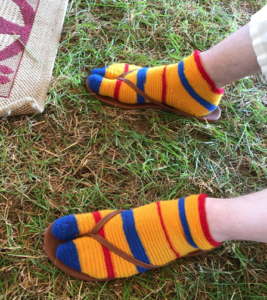
Conclusions and wider implications
There have not been any finds of complete or near-complete socks in the nalbinding technique from elsewhere in the Roman or Byzantine empires. It is clear from the large number of surviving Egyptian socks that they must have been a fairly common item there in the post-Roman era. The use of radio-carbon dating to establish that some of these socks date to the era of Roman rule in Egypt, plus their discovery mostly in Greek-speaking enclaves, suggest that they may have been a Roman (or Hellenized) fashion, rather than one developed in the Egyptian tradition. So, is there any evidence that nalbound socks were used elsewhere in the Roman empire?
There is textual evidence of the use of socks throughout the Roman empire. (Kostner) There are surviving socks sewn from woven cloth from the areas of modern-day France and Britain. (Kostner) However, none of the socks found outside of Egypt have a split toe, meaning they could not have been worn with soleae. Kostner includes in her article a photo of a funerary stele from southern Germany clearly depicting a woman wearing soleae with socks. If people in the northern and northwestern provinces were wearing soleae (which seems to have evidence from other sources as well – Kostner), then it seems likely that they would have seen the need for socks in the colder climate. There is evidence of contemporary use of nalbinding in northern Europe (Classen-Buttner) So, it is certainly possible that this technique, known in Roman Egypt and used elsewhere in northern Europe, could have been widely used in the Roman empire. However, this will have to remain speculation unless or until someone finds more definitive pictorial evidence or an extant example.
Sources and References
Bozsa, Isabella. Museum der Kulturen Basel, private communication, 2018.
Böttcher, Gudrun. “Nadelbindung – Koptische Textilien im Museum der Kulturen Basel und im Städtischen Museum Simeonstift, Trier” Archaeological Textiles Newsletter. No. 39, Autumn 2004.
Burandt, Boris. “Iron footed – hobnail patterns under Roman shoes and their functional meaning.” Small Finds & Ancient Social Practices in the Northwest Provinces of the Roman Empire. Ed. Stephanie Hoss & Alissa Whitmore, (Oxbow Books) 2016.
Burnham, Dorothy. “Coptic Knitting: an ancient technique.” Textile History. vol. 3, No. 1, Dec 1972. pp 116-124.
Claßen-Büttner, Ulrike. Nalbinding – What in the World Is That?, Books on Demand, 2012.
Collin, Maria. “Sydda Vantar.” Fataburen, Nordiska Museet Fataburen, 1917. pp 71-82
Decker, Anne Marie. private communication, 2017-2020.
Decker, Anne Marie. “Charting the Nalbinding of the Nile” Textile Archaeology of Egypt and Sudan seminar, “Current Research in Textile Archaeology along the Nile”, 21 January, 2019.https://uwtsd.hosted.panopto.com/Panopto/ Pages/Viewer.aspx?id=59e82044-f078-4a7d-9b97-a9dc00a89ecb
Dyer J, Tamburini D, O’Connell ER, Harrison A (2018) A multispectral imaging approach integrated into the study of Late Antique textiles from Egypt. PLoS ONE 13(10): e0204699. https://doi.org/10.1371/journal.pone.0204699
Hansen, Egon H. “Nalebinding: definition and description”. Textiles in Northern Archaeology, NESAT III: Textile Symposium In York, 1990.
Kendrick, AF. Catalogue of textiles from burying-grounds in Egypt, Victoria & Albert Museum, London: H. M. Stationery Office, 1920-21.
Köstner, Barbara. “Roman and Late Roman nalbinding socks from Egypt: Bringing ‘Egyptian fashion’ to the North” Excavating, analyzing, reconstructing Textiles of the 1st millennium AD from Egypt and neighboring countries. Ed Antoine De Moor, Cacilia Fluck, and Petra Linscheid, (Lanoo Publishers) 2017.
Köstner, Barbara. “Wearing socks in sandals: The height of Roman fashion?” Small Finds & Ancient Social Practices in the Northwest Provinces of the Roman Empire. Ed. Stephanie Hoss & Alissa Whitmore, (Oxbow Books) 2016.
Leroux, Ernest, ec. Le costume en Egypte du IIIe au XIIIe siècle. Paris:Palais du Costume, 1900.
PFister, R and Bellinger, L. Excavations at Dura Europos, Part II: The Textiles, New Haven: Yale University Press, 1945.
Santrot, Jacques. Au fil du Nil, Couleurs de l’Egypte chrétienne, Paris: Somogy editions d’art, 2001.
Schinnerer, Luise. Antike Handarbeiten, Vienna, 1895.
Van Strydonck, Mary; DeMoor, A; Benazeth, D. “14C Dating Compared to Art Historical Dating of Roman and Coptic Textiles from Egypt”, Radiocarbon Vol 6, No 1, 2004. pp231-244.
Museum Catalogs
These are museums that have online, searchable databases of their collections, with photos of the objects. All of these have nalbound socks.
The British Museum – http://www.britishmuseum.org/research/collection_online/search.aspx
Global Egyptian Museum (collates collections from numerous museums worldwide) – http://globalegyptianmuseum.org/
The Manchester Museum – https://egyptmanchester.wordpress.com/2012/03/22/curators-diary-22312-of-sling-shots-and-coptic-socks/
The Metropolitan Museum of Art – https://metmuseum.org/
Royal Ontario Museum – https://collections.rom.on.ca/search/coptic%20socks#filters
Victoria & Albert Museum – https://www.vam.ac.uk/archives/
